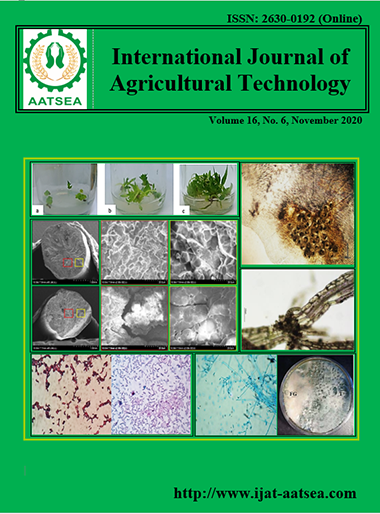Gender, age, farm and slaughter month factors affecting dairy carcass traits and the relationship between the traits, thoracic cavity depth, and carcass length
Main Article Content
Abstract
Farm affected most traits, except for the thoracic cavity depth (TCD), skin weight (SKW) and percentage of skin weight (PSK). Slaughter month had affected all the traits, except for PSK. The relational study, findings showed that the final live weight had highly significant positive correlated with all studied traits (P<0.01), except for TCD and PSK. Hot carcass weight had highly significant positive correlated with dressing percentage of carcass length (CL) and SKW (P<0.01), except for PSK. Dressing percentage did not correlate with TCD and CL. However, the negative correlation between TCD and CL (r = -0.325) was found, whereas the TCD had no correlation with SKW and PKW. However, CL had negative correlation with PSK (r=-0.287), while the relationship between SKW and PSK was 0.586.
Article Details

This work is licensed under a Creative Commons Attribution-NonCommercial-NoDerivatives 4.0 International License.
References
Assan, N. (2013). Bioprediction of body weight and carcass parameters from morphometric measurements in livestock and poultry. Scientific Journal of Review, 2:140-150.
Coopman, F. (2008). Morphometric assessments in the double-muscled Belgian Blue beef breed. Retrieved from https://www.researchgate.net/publication/ 294262990.
Guerrero, A., Valero, M. V., Campo, M. M. and Sañudo, C. (2013). Some factors that affect ruminant meat quality: from the farm to the fork. Review. 2013. Acta Scientiarum. Retrieved from Doi:10.4025/actascianimsci.v35i4.21756.
Orts, F. A. (1959). The relationship of the long bones of the thoracic and pelvic limbs as an indicator of muscling in the beef animal. Reciprocal Meat Conference Proceedings, Columbia, MO, 125 p.
SAS (1999). SAS/STAT User’s Guide: Statistic, SAS Institute Inc. North Carolina.
Sethakul, J. (2016). Fattening dairy beef: the opportunity to entering in market quality beef. In Seminar of Fattening Dairy Beef: Opportunity and Preparedness in Beef Shortage Crisis. Meajo University, Chiang Mai, pp. 1-7.
Taylor, R. E. (1984). Beef Production and the Beef Industry. Macmillan Publishing. New York, New York.
Thairath (2019). El Niño: Keep up with drought in rainny season. Retrieved from https://www.thairath.co.th/news/local/bangkok/ 1539138.
Torrescano Urrutia, G. R., Sánchez Escalante, A., Palmab, V., Gustavo, M., Pellat, R. P. and Pardo Guzmán, D. A. (2010) Characterization of bovine carcasses and meat from animals fattened in Central Sonora. Revista Mexicana de Ciencias Pecuarias, 1:157-168.
Tuntivisoottikul, K. and Limsupavanich, R. (2018). Effects of gender of dairy or beef cattle and the number of pair of permanent incisors on carcass traits. MATEC Web of Conferences, 192, 03050.


